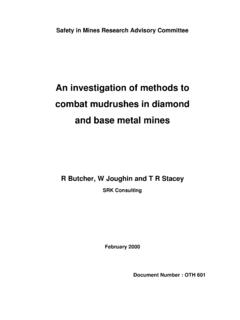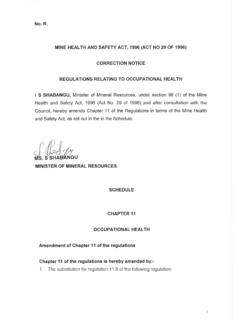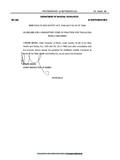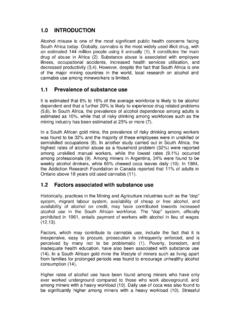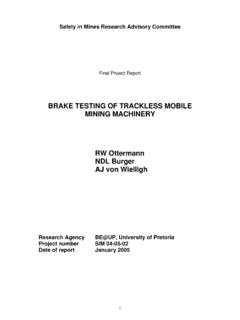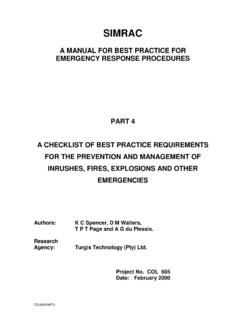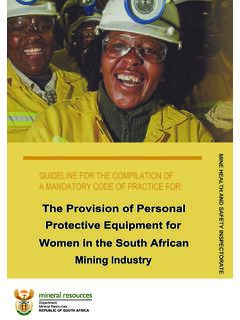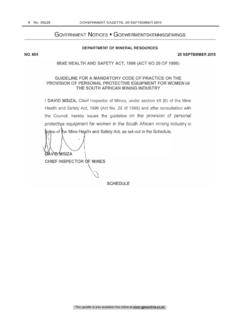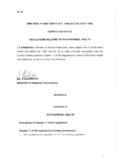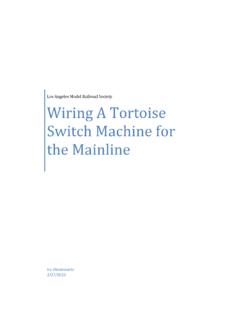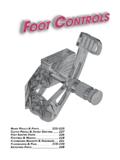Transcription of INVESTIGATE A POSSIBLE SYSTEM FOR “making …
1 1 Safety in Mines Research Advisory CommitteeFinal Project ReportINVESTIGATE A POSSIBLE SYSTEM FOR making safe RW OttermannNDL BurgerAJ von WiellighMF HandleyGA FourieResearch AgencyRE@UP, University of PretoriaProject numberGEN 801 Date of reportFebruary 2002 2 EXECUTIVE SUMMARYThe primary output of this phase1 of the project was to develop a list ofalternative designs for making safe that may be considered by responsible for making safe in mines will use the device or SYSTEM ,which has to be safe and reliable and reduce the exposure to fall ofunsupported ground hazards, and therefore saving life and limb. This projectlooks at the actual making safe and not the detection of loose rock, which isaddressed in projects GAP 820 and GAP 822.
2 During phase 2 of the projecta working prototype or prototypes will be developed for significant proportion of rockfall accidents occur during re-entry into aworkplace, when the initial inspection and making safe procedures arecarried out to stabilise the rock before work in the area begins. The reason isthat making safe is one of the most stressful and dangerous activities anunderground miner can undertake. The operator often is unable to work at asafe distance and is sometimes forced to work directly underneath unstablerock when attempting to make safe . The equipment currently used isarchaic and there is a need to devise a simple SYSTEM to enable operators tostabilise the rock effectively and efficiently from a safe distance before workbegins in the literature and international survey on existing systems was a problem survey different mines (gold, platinum and coal) withdifferent stoping widths were visited to INVESTIGATE and identify the problem.
3 Afunctional analysis was done from which a specification was drawn concepts for making safe were generated and evaluated againstthe SYSTEM specifications. These concepts were presented to ideas developed during this project are to be used by workersresponsible for making safe in mines. The equipment is designed to reduceexposure to falls of ground, and to assist in reducing stress and fatigue of theoperator. The concepts chosen as the preferred concepts are: A lightweight pinch-bar where the bar is manufactured of compositematerials. Mechanical jaws : A hand held and operated mechanical SYSTEM ,which makes use of hydraulic pressure activated jaws to pry is recommended that both preferred concepts be further developed intoprototypes, which can be tested and evaluated.
4 It is further recommendedthat the Canadian mechanised scaling tool developed and tested by Planeta(1995) should be investigated and tested in South African authors would like to express their gratitude to the Safety in MinesResearch Advisory Committee (SIMRAC) for financial support of project GEN801 and also for the interest and technical input of the SIMRAC TechnicalCommittee. The team would also like to thank the three mines visited for theirhospitality and assistance in observing making safe OF CONTENTS OF LOCAL OF INTERNATIONAL REMARKS ON BARRING PRACTICE ON SOUTH AFRICAN OF ANALYSIS AND PINCH-BAR.
5 INTO COATING OF JAWS ..279 CONCLUSION AND A SCALING REGULATIONS IN WESTERN B FUNCTIONAL OF FIGURESF igure 3-1 Mechanised scaling/tool (Planeta. 1955)..11 Figure 5-1 SYSTEM level functional 6-1 Air bag in 6-2 Vacuum suction concept 6-3 Mechanical scaling 6-4 Rock prying apparatus in 6-5 Glue into 6-6 Coating of the 8-1 Lightweight 8-2 Rock prying apparatus in 8-3 Layout of rock prying 8-4 Front end of rock prying INTRODUCTIONA significant proportion of rockfall accidents occur during inspection and making safe operations to stabilise the rock before work in the area reason is that making safe is one of the most stressful and dangerousactivities an underground miner can undertake.
6 The operator often is unableto work at a safe distance and is sometimes forced to work directlyunderneath unstable rock when attempting to make safe . The equipmentcurrently used is archaic and there is a need to devise a simple SYSTEM toenable operators to stabilise the rock effectively and efficiently from a safedistance before work begins in the equipment developed during this project is to be used by workersresponsible for making safe in mines. This project looks at the actual making safe and not the detection of loose rock, which is addressed inprojects GAP 820 and GAP 822. This equipment will reduce the exposure tofall of unsupported ground hazards, and therefore saving life and is the final report on project GEN 801.
7 During this project differentconcepts for making safe were generated and evaluated against the systemspecification. These concepts were presented to METHODOLOGYThis project adopted the following approach: The team carried out a local and international literature survey onexisting systems to establish current practice and ideas in themining industry. Three different producing mines (gold, platinum and coal) werevisited in South Africa to view current practice. A functional analysis based on the findings of the underground visitswas done. From the functional analysis the requirements for the SYSTEM werefinalised and the SYSTEM specification and design parameters drawnup. The team generated different ideas.
8 The different concepts were evaluated against the systemspecification. The selected concepts were presented to LITERATURE SURVEYThe literature survey is split into surveys of the local and Survey of Local LiteratureFrom the beginning of the 20th Century, injury statistics for theWitwatersrand Gold Mines showed a steady reduction in the injury ratefrom all other causes, excepting rockfalls. By 1929 Watermeyer andHoffenberg (1932) reported that rockfall injuries were responsible for 25%of all injuries in the Witwatersrand Gold Mines. By 1943, the proportion ofrockfall injuries on the gold mines had climbed to 50%, because injuryrates from all other causes had continued to decline while those fromrockfalls continued to remain almost constant (Biccard Jeppe, 1946).
9 Rockfalls are still responsible for a significant proportion of non-fatal andfatal injuries in the gold and platinum mining sector, and there is nosignificant downward trend in these statistics in either the gold or platinummines since 1970 (Jager and Ryder, 1999).This picture suggests that the problem of rockfalls has never really beenaddressed effectively. The fatal injury rate has declined in the gold miningsector from workers per 1000 workers employed per year in 1943 average in the years 1996-2000. Although this represents a 50%reduction, this has taken 50 years to achieve, and can probably beascribed to the general incremental improvement in support and supportproducts, mining strategy, the implementation of mining regulations,gradual improvements in management and supervision practice, improvedlevels of education and training, and a gradual improvement in theunderstanding of the mining industry addresses the rockfall problem by the process of making safe , which consists of the following three components:1.
10 A qualified person first enters the working place and carries out a visualinspection;2. Unsafe hangingwall rock and sidewalls identified in the visualinspection are barred down;3. The excavation is supported, either with temporary or this process is complete, mining activities may begin in the problem has been discussed for many years, often omitting points 1 to3 above, instead emphasising mining strategy, mine planning, regionalsupport strategy, local support, and supervision. Reviewing transactions inthe Papers and Discussions of the Association of Mine Managers of South9 Africa, covering stoping, stoping methods, safety and safety and health, itappears that there is no mention of the procedures for visual inspections inany of the papers spanning the years 1931 to 1996, including for examplethe reply by Hildick-Smith (1948, pp 998-1014) in which the StandardStoping Practice at Modderfontein B Gold Mines Limited is set out in is very little covering the second point.
